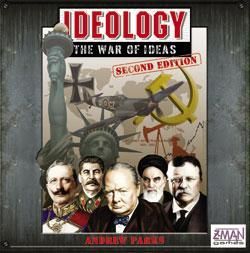Ideology: The War of Ideas (2003) Board Game
Ideology: The War of Ideas’ is a board game that was released in in 2003. Designed by Andrew Parks, Jim Parks, and C. James Parks, this game falls under the political card game category. The game focuses on the concept of ideology and players must use alliances, area majority/influence, and variable player powers to dominate the game.
Game Components of Ideology: The War of Ideas
How To Setup Ideology: The War of Ideas
Players start by drawing an Ideology card, which defines their starting region and initial Influence cards. In a two-player game, the second player’s ideology is chosen for balance against the first player’s. Each starting region begins with a Development Level of 3 and three Influence cards of each type (Military, Economic, Cultural) placed on the region card. Players dominate their starting region and are ready to expand and influence other regions.
Gameplay Mechanics and Game Objective
Player Experience
Playing *Ideology: The War of Ideas* can be a complex and engaging experience. The game requires strategic thinking and resource management, as players must balance their efforts to develop their own regions while trying to influence and take over others. The game can take up a significant amount of space and time, with average gameplay lasting 1-2 hours, though it can extend to nearly 4 hours as players get accustomed to the mechanics.
Pros
Cons
Personal Thoughts on Ideology: The War of Ideas
*Ideology: The War of Ideas* is best suited for experienced board game enthusiasts who enjoy complex strategy and area control games. It is not a casual “beer and pretzels” game but rather a game that requires careful planning and execution. The unique theme and dynamic gameplay make it an interesting choice for those who want to explore different ideologies and their interactions in a simulated world context. However, due to its complexity and length, it may not be the best fit for new players or those looking for a quick gaming session.
We are supported by our audience. When you purchase through links on our site, we may earn an affiliate commission, at no extra cost for you. Learn more.

